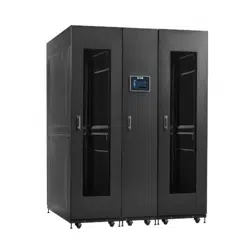Loading ...
Loading ...
Loading ...

8
2. Operation and Maintenance
• Control Mode:
• Supply air (default): The cooling control strategy will be based off the temperature of the discharge air.
• Return air: The cooling control strategy will be based off the temperature of the entering air.
Note: If the load is lower than 30% of rated cooling capacity, which may cause frequent In-Row Cooler on/off cycling, it is
recommended to set Control Mode to “Return Air.” Otherwise, set Control Mode to “Supply Air.”
• Restart delay time: Restart delay after restoring power. If power is lost, the In-Row Cooler will automatically restart after
this delay time.
Set up group control to ensure redundancy if there is a cooling fault or to balance run hours to ensure average run hours
across all In-Row Coolers is similar:
• Standby Unit IP: The IP address of the standby air conditioner. The master In-Row Cooler will send commands to this IP
address. If configured as a standby In-Row Cooler, an IP address is not needed.
• This Unit: Designates whether the In-Row Cooler is a master or standby In-Row Cooler. Each standby In-Row Cooler must
have a corresponding master.
• Master Control: Recommended setting is “Enabled.” When enabled, this means the standby In-Row Cooler will be running
the same control modes as the master to prevent demand fighting. Control modes are: cooling and dehumidifying.
• Rotation Time: Number of days each In-Row Cooler should operate until rotating to the next one.
• Rotation: When enabled, this means after the rotation time expires, the master In-Row Cooler will stand by and the existing
standby In-Row Cooler will resume. This helps balance the run hours between each In-Row Cooler.
Note: In-Row coolers will not rotate if the heat load demands additional cooling.
• Force On: When enabled, if the master In-Row Cooler issues an alarm, it will force the standby In-Row Cooler to function,
regardless of the rotation configuration.
• Group Unit Quantity: Used to set the total size (number of In-Row Coolers) of the group.
• Standby Unit Quantity: Use to set the number of “redundant” In-Row coolers within the group reserved for standby.
• Monitor: This is the In-Row Cooler MODBUS address used for the DCIM.
Loading ...
Loading ...
Loading ...
